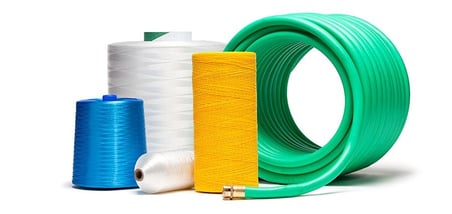 Synthetic yarns like nylon and polyester are typically known for their high shrinkage rate. In order to permanently set the physical properties of these materials after extrusion, they are stretched or drawn at elevated temperatures under tension during the manufacturing process, also known as heat setting. When stretched under these elevated temperatures, changes in physical properties happen and the crystallinity of these synthetic yarns is modified. The general physical properties of the thread or yarn can be adjusted by selecting the specific conditions under which the yarn is drawn, bringing the desired property changes to the material. Heat setting also stabilizes the yarn for future exposure to heat.
Synthetic yarns like nylon and polyester are typically known for their high shrinkage rate. In order to permanently set the physical properties of these materials after extrusion, they are stretched or drawn at elevated temperatures under tension during the manufacturing process, also known as heat setting. When stretched under these elevated temperatures, changes in physical properties happen and the crystallinity of these synthetic yarns is modified. The general physical properties of the thread or yarn can be adjusted by selecting the specific conditions under which the yarn is drawn, bringing the desired property changes to the material. Heat setting also stabilizes the yarn for future exposure to heat.
The ASTM D4974 method is primarily indicated for nylon, polyester, and other heat tolerant materials such as aramids used in tire cord, belt reinforcement, and other MRG (mechanical rubber goods) products that require vulcanization of the rubber. During the vulcanization process, the rubber is exposed to high heat for a period of time, stabilizing it and giving it its final physical characteristics (similar to the heat-setting process for textiles). A standard high shrinkage industrial yarn, in a rubber hose for example, will constrict the ID of the hose during vulcanization. Low shrinkage yarns (those that have been heat-set under the proper conditions) are designed to be more physically stable when exposed to heat and are a much better selection for this type of product.
During the ASTM D4974 testing procedure, a hot air thermal shrinkage oven is used to subject the specimen of yarn or cord to dry heat for a specified period of time while under a specified tension. The percent shrinkage is read directly from a scale or display on the instrument while the specimen is still under tension and exposed to heat.
The standard ASTM D4974 testing method is to heat the sample to 177 deg C for 2 minutes with a pretension load of 0.05 grams per denier. A lower pretension value of 0.01 gpd is also mentioned in the standard for yarns with lower shrinkage values in order to give a more accurate reading. The specific machine we use, manufactured by Testrite, comes standard with a 9 gram weight with other weights available. As a general rule, a higher pretension weight will typically reduce the shrinkage values recorded.
There are many testing variations, and not all raw material manufacturers follow the ASTM D4974 method when testing their materials. Also, materials with lower melting points require a lower temperature to determine shrinkage. Therefore, it is common to see the specific shrinkage test method called out on raw material specifications so that the end user can match up with the numbers reported by the supplier. If a supplier tests at a condition of 190C for 10 minutes with a 9g pretension, you can get a vastly different result with material from another supplier who tests at 177C for 2 mins at 0.05 g/dn. However, when both of these yarns are tested under the same conditions, they may be nearly identical. Wherever the method is not specified, we default to the ASTM D4974 testing method.
This is one of the many ASTM tests Service Thread uses to ensure our product quality meets or exceeds our customers expectations.
To fully understand the setup, procedure and interpretation of results, contact our experienced representatives who can help you with testing implementation.



